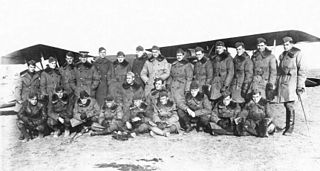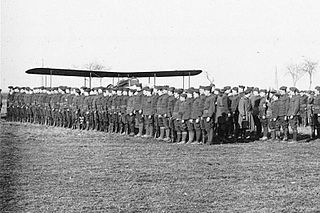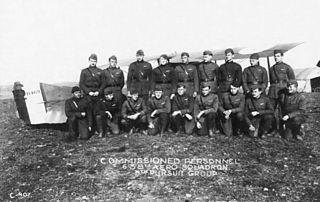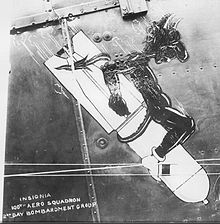
The 13th Aero Squadron was a United States Army Air Service unit that fought on the Western Front during World War I.

The 99th Aero Squadron was an Air Service, United States Army unit that fought on the Western Front during World War I.

Toul-Croix De Metz Airfield is a former military airfield which is located approximately one mile (1.6 km) northeast of Toul ; 160 miles (260 km) east of Paris.

The 25th Aero Squadron was a United States Army Air Service unit that fought on the Western Front during World War I.

The 49th Aero Squadron was a United States Army Air Service unit that fought on the Western Front during World War I.

The 135th Aero Squadron was a United States Army Air Service unit that fought on the Western Front during World War I.

The 139th Aero Squadron was a United States Army Air Service unit that fought on the Western Front during World War I.

The 22nd Aero Squadron was a United States Army Air Service unit that fought on the Western Front during World War I.

The III Corps Observation Group was a United States Army Air Service unit that fought on the Western Front during World War I as part of the Air Service, First United States Army. It was demobilized on 12 May 1919. There is no modern United States Air Force unit that shares its lineage and history.

The IV Corps Observation Group was an Air Service, United States Army unit that fought on the Western Front during World War I. It was demobilized on 12 May 1919. There is no modern United States Air Force unit that shares its lineage and history.

The Organization of the Air Service of the American Expeditionary Force on November 11, 1918, represents its maximum strength in World War I. Units of the Air Service are listed as assigned to the order of battle for that date, which was that of the Armistice with Germany. The first air unit arrived in France in September 1917, while the final air unit reaching the front did so on November 9, 1918. Unit operations began in April 1918. At the armistice, 57,508 officers and men served in the Air Service of the AEF, 24,512 in the Zone of Advance, and 32,996 in the Services of Supply. Of its 6,861 officers, 4,088 were on flying status and 219 were qualified observation balloon aviators. 1,724 of those on flying status and approximately 100 of the balloonists served in combat units.
Belrain Aerodrome was a temporary World War I airfield in France. It was located 0.7 miles (1.1 km) South of Belrain, in the Meuse department in the Lorraine region in northeastern France.

The 85th Aero Squadron was an Air Service, United States Army unit that fought on the Western Front during World War I.

The 4th Pursuit Group was a United States Army Air Service unit that fought on the Western Front during World War I as part of the Air Service, Second United States Army. It was demobilized in France on 15 April 1919. There is no modern United States Air Force unit that shares its lineage and history.

The VII Corps Observation Group was an Air Service, United States Army unit that fought on the Western Front during World War I as part of the First Army Air Service. It was later transferred to the Third Army Air Service as part of the United States Occupation of the Rhineland after the 1918 Armistice with Germany.

The 168th Aero Squadron was a United States Army Air Service unit that fought on the Western Front during World War I.

The 278th Aero Squadron was a United States Army Air Service unit that fought on the Western Front during World War I.

The 5th Pursuit Group was an Air Service, United States Army unit that was assigned to the American Expeditionary Forces during World War I. It was demobilized in Germany after serving with the Third Army Air Service as part of the American Occupation of the Rhineland in May, 1919. There is no modern United States Air Force unit that shares its lineage and history.

The 638th Aero Squadron was an Air Service, United States Army unit that fought on the Western Front during World War I.

The Third Army Air Service was a United States Army Air Service organization stationed in France and Occupied Germany in the immediate aftermath of World War I. It was demobilized in Germany on 2 July 1919. There is no modern United States Air Force unit that shares its lineage and history.






















